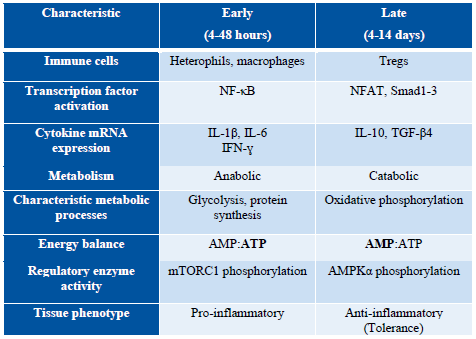Immunometabolism: The Potential Cause of and Solution to Our Most Pressing Poultry Problems in Health and Infectious Disease
Poultry, and chicken specifically, have been a research model organism for decades. Much of our most fundamental and consequential discoveries in immunology and disease have come from the study of poultry. These discoveries cross the research spectrum from oncogenes to B-cells. At the same time chickens have been aggressively, and successfully, bred for greater growth and feed efficiency. While this breeding has been an indisputable success in terms of food animal production, it has had consequences in terms of emerging and re-emerging disease challenges in poultry. These challenges have a common theme in the form of the recent research perspective called immunometabolism. Immunometabolism refers to the interconnectedness of immune responses and metabolic processes. We can use an immunometabolic perspective to better understand poultry disease, both infectious and not. Immunometabolism has pointed to potential mechanisms of woody breast, the tolerance of chicken toward Salmonella, and the devastating effects of coccidiosis and necrotic enteritis. The challenges that we face in growing poultry ever more efficiently is coupled with greater restrictions on how poultry production is managed. These challenges of immunometabolism are also an opportunity. An integrated metabolic and immunologic perspective allows us to more fully understand disease pathogenesis and the mechanism of action of effective disease interventions. Importantly, it also opens up an entirely new world of possible solutions, nutritional and metabolic solutions, to the pressing health and disease problems in poultry.

Chaplin, D.D. (2010). Overview of the immune response. J. Allergy Clin. Immunol. 125, S3–S23.
Havenstein, G., Ferket, P., and Qureshi, M. (2003). Growth, livability, and feed conversion of 1957 versus 2001 broilers when fed representative 1957 and 2001 broiler diets. Poult. Sci. 82, 1500–1508.
He, C., and Carter, A.B. (2015). The Metabolic Prospective and Redox Regulation of Macrophage Polarization. J. Clin. Cell. Immunol. 6, 371.
Johnson, C.N., Kogut, M.H., Genovese, K., He, H., Kazemi, S., and Arsenault, R.J. (2019). Administration of a Postbiotic Causes Immunomodulatory Responses in Broiler Gut and Reduces Disease Pathogenesis Following Challenge. Microorganisms 7, 268.
Klasing, K.C. (2007). Nutrition and the immune system. Br. Poult. Sci. 48, 525–537.
Kogut, M.H., and Arsenault, R.J. (2015). A Role for the Non-Canonical Wnt-β-Catenin and TGF-β Signaling Pathways in the Induction of Tolerance during the Establishment of a Salmonella enterica Serovar Enteritidis Persistent Cecal Infection in Chickens. Front. Vet. Sci. 2.
Kogut, M.H., and Arsenault, R.J. (2017). Immunometabolic Phenotype Alterations Associated with the Induction of Disease Tolerance and Persistent Asymptomatic Infection of Salmonella in the Chicken Intestine. Front. Immunol. 8.
Kogut, M.H., Swaggerty, C.L., Chiang, H.-I., Genovese, K.J., He, H., Zhou, H., and Arsenault, R.J. (2014). Critical role of glycogen synthase kinase-3β in regulating the avian heterophil response to Salmonella enterica serovar Enteritidis. Vet. Infect. Dis. 1, 10.
Mathis, D., and Shoelson, S.E. (2011). Immunometabolism: an emerging frontier. Nat. Rev. Immunol. 11, 81–83.
McDade, T.W., Georgiev, A.V., and Kuzawa, C.W. (2016). Trade-offs between acquired and innate immune defenses in humans. Evol. Med. Public Health 2016, 1–16.
Mockler, M.B., Conroy, M.J., and Lysaght, J. (2014). Targeting T Cell Immunometabolism for Cancer Immunotherapy; Understanding the Impact of the Tumor Microenvironment. Front. Oncol. 4, 107.
Papah, M.B., Brannick, E.M., Schmidt, C.J., and Abasht, B. (2018). Gene expression profiling of the early pathogenesis of wooden breast disease in commercial broiler chickens using RNAsequencing. PLoS One 13.
Quiroz-Castañeda, R.E., and Dantán-González, E. (2015). Control of avian coccidiosis: future and present natural alternatives. BioMed Res. Int. 2015.
Shanmugasundaram, R., Kogut, M.H., Arsenault, R.J., Swaggerty, C.L., Cole, K., Reddish, J.M., and Selvaraj, R.K. (2015). Effect of Salmonella infection on cecal tonsil regulatory T cell properties in chickens. Poult. Sci. pev161.
Stern, C.D. (2005). The chick: a great model system becomes even greater. Dev. Cell 8, 9–17.
Taylor Jr, R.L., and McCorkle Jr, F.M. (2009). A landmark contribution to poultry science—Immunological function of the bursa of Fabricius. Poult. Sci. 88, 816–823.
Wang, X., Peebles, E.D., Kiess, A.S., Wamsley, K.G., and Zhai, W. (2019). Effects of coccidial vaccination and dietary antimicrobial alternatives on the growth performance, internal organ development, and intestinal morphology of Eimeria-challenged male broilers. Poult. Sci. 98, 2054–2065.
Weiss, R.A. (1998). The oncologist’s debt to the chicken. Avian Pathol. 27, S8–S15.
Williams, H.H. (1998). Delmarva’s Chicken Industry: 75 Years of Progress. Delmarva Poultry Industry, Inc.
National Chicken Council. "U.S. Broiler Performance". https://www.nationalchickencouncil.org/about-the-industry/statistics/u-s-broiler-performance/. Accessed February 20, 2020.










.jpg&w=3840&q=75)